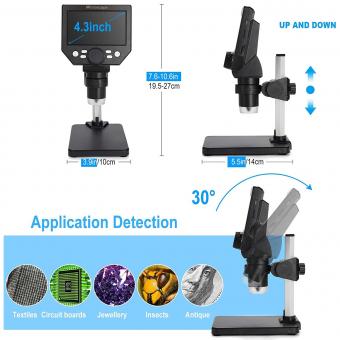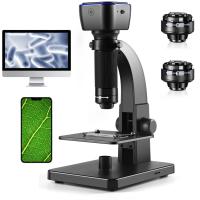What Can You See With 2500x Microscope ?
With a 2500x microscope, you can see highly magnified details of various objects and specimens. This level of magnification allows you to observe intricate structures and features that are not visible to the naked eye. For example, you can examine the fine details of cells, such as their organelles and cell walls. Additionally, you can explore the world of microorganisms, observing bacteria, fungi, and other tiny organisms in great detail. With this microscope, you can also study the structure of plant and animal tissues, observing the arrangement of cells and their components. Furthermore, you can investigate the morphology of small insects, such as the intricate patterns on their wings or the structure of their exoskeletons. In summary, a 2500x microscope provides a powerful tool for exploring the microscopic world and uncovering the hidden details of various specimens.
1、 Cellular structures and organelles in greater detail
With a 2500x microscope, you can observe cellular structures and organelles in much greater detail than with lower magnification microscopes. This level of magnification allows for a closer examination of the intricate components that make up a cell.
At this magnification, you can observe the nucleus of a cell with greater clarity. The nucleus, often referred to as the control center of the cell, contains the genetic material and is responsible for regulating cell activities. With a 2500x microscope, you can see the nuclear envelope, nucleolus, and chromatin fibers within the nucleus.
Additionally, you can observe the mitochondria, which are the powerhouses of the cell. These organelles produce energy in the form of ATP through cellular respiration. With a higher magnification, you can see the inner membrane folds called cristae, which increase the surface area for energy production.
Other organelles such as the endoplasmic reticulum, Golgi apparatus, and lysosomes can also be observed in greater detail. The endoplasmic reticulum is involved in protein synthesis and lipid metabolism, while the Golgi apparatus modifies and packages proteins for transport. Lysosomes contain enzymes that break down waste materials within the cell.
Furthermore, a 2500x microscope allows for the observation of cellular structures like microtubules, microfilaments, and intermediate filaments. These structures provide support, shape, and movement within the cell.
It is important to note that the latest advancements in microscopy techniques, such as super-resolution microscopy, have pushed the boundaries of what can be observed at the cellular level. These techniques allow for even higher magnification and resolution, enabling scientists to study cellular structures and organelles with unprecedented detail.

2、 Bacteria and other microorganisms at a higher resolution
With a 2500x microscope, you can observe a wide range of microscopic organisms and structures with significantly higher resolution than with lower magnification microscopes. At this level of magnification, you can explore the intricate details of bacteria and other microorganisms, providing valuable insights into their morphology and behavior.
Bacteria, which are single-celled organisms, can be observed in great detail with a 2500x microscope. You can visualize their cell walls, flagella, pili, and other structures that play crucial roles in their survival and reproduction. This level of magnification allows for the identification and classification of different bacterial species based on their unique characteristics.
Furthermore, a 2500x microscope enables the observation of other microorganisms such as protozoa, algae, and fungi. These organisms exhibit diverse shapes, sizes, and structures, which can be explored in detail. For example, you can observe the cilia or flagella of protozoa, the chloroplasts of algae, and the hyphae of fungi.
In addition to microorganisms, a 2500x microscope can also reveal finer details of cellular structures within larger organisms. For instance, you can examine the intricate arrangement of cells in plant tissues, the complex structure of animal cells, and even the internal components of cells such as mitochondria, nuclei, and organelles.
It is important to note that the latest advancements in microscopy techniques, such as confocal microscopy and super-resolution microscopy, have pushed the boundaries of resolution even further. These techniques allow for the visualization of subcellular structures and molecular interactions with unprecedented clarity. However, a 2500x microscope still provides a valuable level of resolution for studying microorganisms and cellular structures in various scientific fields, including microbiology, pathology, and cell biology.

3、 Fine details of plant and animal tissues
With a 2500x microscope, you can observe and study the fine details of plant and animal tissues with remarkable clarity and precision. This level of magnification allows for a closer examination of cellular structures, enabling scientists and researchers to gain a deeper understanding of the intricate workings of living organisms.
When observing plant tissues, a 2500x microscope can reveal the intricate cellular arrangements within leaves, stems, and roots. It allows for the examination of cell walls, chloroplasts, and other organelles involved in photosynthesis. This level of magnification can also help identify and study the presence of pathogens or diseases affecting plant tissues, aiding in the development of effective treatments or preventive measures.
Similarly, when studying animal tissues, a 2500x microscope can provide insights into the cellular composition of various organs and systems. It allows for the examination of muscle fibers, nerve cells, and blood vessels, among other structures. This level of magnification can aid in the identification of abnormalities or diseases within animal tissues, contributing to advancements in veterinary medicine and human health research.
It is important to note that the latest advancements in microscopy techniques, such as confocal microscopy or super-resolution microscopy, can provide even higher levels of magnification and resolution. These techniques allow for the visualization of structures at the nanoscale, providing unprecedented insights into the molecular and subcellular processes within plant and animal tissues.
In conclusion, a 2500x microscope offers a powerful tool for studying the fine details of plant and animal tissues. However, it is worth considering the latest advancements in microscopy techniques to further enhance our understanding of the complex biological systems that surround us.

4、 Blood cells and their morphology
With a 2500x microscope, one can observe and study various aspects of blood cells and their morphology in great detail. This level of magnification allows for a comprehensive examination of the different types of blood cells, their structures, and any abnormalities that may be present.
Red blood cells, also known as erythrocytes, can be observed in their characteristic biconcave shape. Their size, shape, and color can provide valuable information about a person's overall health and potential disorders such as anemia or sickle cell disease. The microscope can reveal any irregularities in the shape or size of red blood cells, which can indicate certain genetic or acquired conditions.
White blood cells, or leukocytes, can also be examined at this magnification. Different types of white blood cells, including neutrophils, lymphocytes, monocytes, eosinophils, and basophils, can be identified and their relative proportions can be determined. This information is crucial in assessing the body's immune response and diagnosing various infections, autoimmune disorders, or blood cancers.
Furthermore, platelets, the smallest blood cells, can be observed in detail. Platelets play a vital role in blood clotting, and their examination can help identify any abnormalities or deficiencies that may lead to bleeding disorders.
It is important to note that the latest advancements in microscopy techniques, such as fluorescence microscopy and confocal microscopy, can provide even more detailed information about blood cells. These techniques allow for the visualization of specific cellular components, such as the nucleus or specific proteins, providing a deeper understanding of cellular function and potential abnormalities.
In conclusion, a 2500x microscope enables the observation and analysis of blood cells and their morphology, providing valuable insights into a person's health and aiding in the diagnosis of various blood disorders.





































